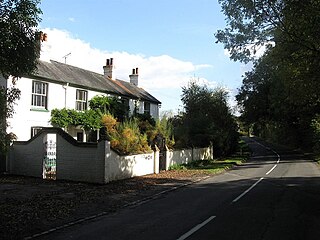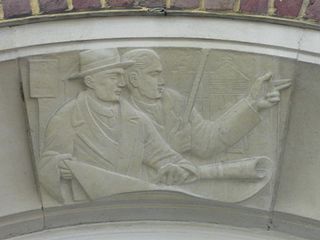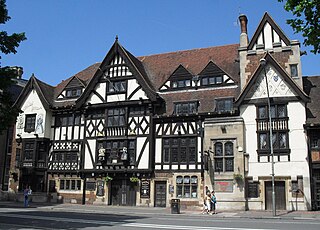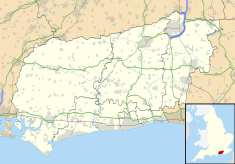
Shoreham-by-Sea is a coastal town and port in West Sussex, England.

Lancing is a large coastal village and civil parish in the Adur district of West Sussex, England, on the western edge of the Adur Valley. It occupies part of the narrow central section of the Sussex coastal plain between smaller Sompting to the west, larger Shoreham-by-Sea to the east, and the parish of Coombes to the north. Excluding definitive suburbs it may have the largest undivided village cluster in Britain. However, its economy is commonly analysed as integral to the Brighton/Worthing/Littlehampton conurbation. Its settled area beneath the South Downs National Park covers 3.65 square miles, the majority of its land.

Southwick is a town in the Adur district of West Sussex, England located five miles (8 km) west of Brighton. It covers an area of 863.7 ha.

Wivelsfield village and the larger adjacent village of Wivelsfield Green are the core of the civil parish of Wivelsfield in the Lewes District of East Sussex, England. The villages are 9.3 miles (15.0 km) north of the city of Brighton and Hove.
Kingston by Sea, also known as Kingston Buci, Kingston Bucii or simply Kingston, is a small area in the Adur district of West Sussex, England. Although it is now part of a continuous urban area, its origins lay in an ancient village and parish church between Southwick to the east, Shoreham-by-Sea to the west and the mouth of the River Adur to the south. St Julian's Church survives, and its parish perpetuates the ancient "Kingston Buci" name.

Shoreham Tollbridge is a bridge crossing the River Adur in West Sussex, England. It is the last of its kind in Sussex and one of the last of its kind anywhere in the world.

Erringham chapel is a former place of worship in the deserted medieval village of Old Erringham, north of Shoreham-by-Sea in the district of Adur, one of seven local government districts in the English county of West Sussex. Founded in the 11th century as a chapel of ease to St Nicolas' Church in the Saxon riverside village of Old Shoreham, it was in use for several centuries until depopulation caused Old Erringham to become unviable as a settlement. The chapel fell into ruin, and its remains have been incorporated into a barn on the farm which now occupies the site of the village. English Heritage has listed the remaining structure at Grade II for its architectural and historical importance.

The name St Peter's Church has been borne by two Roman Catholic churches in the town of Shoreham-by-Sea in the district of Adur, in the English county of West Sussex. The original church with that dedication was the town's first permanent Roman Catholic place of worship; founded in 1875, it was paid for by Augusta, Duchess of Norfolk, a member of the most important Dukedom in England. After its closure, a new St Peter's Church was built nearby. The old building, which still stands and is in residential use, has been listed by English Heritage at Grade II for its architectural and historical importance.
The district of Adur, one of seven local government districts in the English county of West Sussex, has 119 buildings with listed status. The urbanised southern part of the district forms part of the Brighton/Worthing/Littlehampton conurbation, and most listed structures are in the three main centres of population: Southwick, Shoreham-by-Sea and Lancing. The towns have grown residentially and industrially in the 20th century, but all three have ancient origins as villages and manors on the banks of the River Adur and the English Channel coast. The rest of Adur district's territory is remote downland countryside with scattered farms and hamlets; some of their buildings also have listed status.

Bethel Baptist Chapel is a Strict Baptist place of worship in the village of Wivelsfield in East Sussex, England. The cause was founded in 1763 by members of a chapel at nearby Ditchling; Henry Booker and other worshippers seceded and began to meet at Wivelsfield after hearing a sermon by George Whitefield. Although some members of the new church soon returned to the Ditchling congregation, the cause thrived under Booker's leadership, and the present chapel—a building of "quiet and unassuming elegance" set in its own graveyard—was erected in 1780. It has served the Strict Baptist community continuously since then, and members founded other chapels elsewhere in Sussex during the 18th and 19th centuries. The chapel is a Grade II Listed building.

Ditchling Unitarian Chapel is a Unitarian chapel in Ditchling, a village in the English county of East Sussex. A congregation of General Baptists began to meet in the 17th century in the village, which was a local centre for Protestant Nonconformist worship, and by the time the present simple Vernacular-style chapel was constructed in 1740 a large proportion of the population held Baptist beliefs. Along with other General Baptist chapels in Sussex, the congregation moved towards Unitarian views in the mid-18th century; this caused a schism which resulted in a new chapel being formed at nearby Wivelsfield. The character of the Ditchling chapel was wholly Unitarian by 1800, and it has continued under various names since then. People associated with the chapel include William Hale White, Henry Acton, Adrian Boult—who was married there—and G. K. Chesterton. The chapel is set back from Ditchling's main street and has an adjoining house and graveyard, all of which contribute to the character of the conservation area which covers the centre of Ditchling village. English Heritage has listed the chapel at Grade II for its architectural and historical importance.

John Leopold DenmanFRIBA was an architect from the English seaside resort of Brighton, now part of the city of Brighton and Hove. He had a prolific career in the area during the 20th century, both on his own and as part of the Denman & Son firm in partnership with his son John Bluet Denman. Described as "the master of ... mid-century Neo-Georgian", Denman was responsible for a range of commercial, civic and religious buildings in Brighton, and pubs and hotels there and elsewhere on the south coast of England on behalf of Brighton's Kemp Town Brewery. He used other architectural styles as well, and was responsible for at least one mansion, several smaller houses, various buildings in cemeteries and crematoria, and alterations to many churches. His work on church restorations has been praised, and he has been called "the leading church architect of his time in Sussex"; he also wrote a book on the ecclesiastical architecture of the county.
Clayton & Black were a firm of architects and surveyors from Brighton, part of the English city of Brighton and Hove. In a career spanning the Victorian, Edwardian and interwar eras, they were responsible for designing and constructing an eclectic range of buildings in the growing town of Brighton and its neighbour Hove. Their work encompassed new residential, commercial, industrial and civic buildings, shopping arcades, churches, schools, cinemas and pubs, and alterations to hotels and other buildings. Later reconstituted as Clayton, Black & Daviel, the company designed some churches in the postwar period.

The King and Queen is a pub in the seaside resort of Brighton, part of the city of Brighton and Hove. The present building, a "striking" architectural "pantomime" by the prolific local firm Clayton & Black, dates from the 1930s, but a pub of this name has stood on the site since 1860—making it one of the first developments beyond the boundaries of the ancient village. This 18th-century pub was, in turn, converted from a former farmhouse. Built using materials characteristic of 16th-century Vernacular architecture, the pub is in the Mock Tudor style and has a wide range of extravagant decorative features inside and outside—contrasting with the simple design of the neighbouring offices at 20–22 Marlborough Place, designed a year later. English Heritage has listed the pub at Grade II for its architectural and historical importance.

The Royal Pavilion Tavern, commonly known as the Pavilion Tavern or Pav Tav and since February 2022 as The Fitz Regent, is a pub in the centre of Brighton, part of the English coastal city of Brighton and Hove. Converted from a house into the Royal Pavilion Hotel in the early 19th century, its original role soon changed from a hotel to a pub, in which guise it remained until its closure in September 2019. It reopened under its new name, but still in the ownership of the Mitchells & Butlers chain, on 13 February 2022. The building was also used as a court for several years early in its history, and prominent local architect Amon Henry Wilds was responsible for its redesign as a hotel and inn. English Heritage has listed the building at Grade II for its architectural and historical importance, and it stands within a conservation area.

Prestonville is a largely residential area in the northwest of Brighton, part of the English city of Brighton and Hove. It covers a long, narrow and steeply sloping ridge of land between the Brighton Main Line and Dyke Road, two major transport corridors which run north-northwestwards from the centre of Brighton. Residential development started in the 1860s and spread northwards, further from central Brighton, over the next six decades. The area is characterised by middle-class and upper-middle-class housing in various styles, small-scale commercial development and long eastward views across the city. Two Anglican churches serve Prestonville—one at each end of the area—and there are several listed buildings.

Shoreham Town Hall is a municipal building in the High Street, Shoreham-by-Sea, West Sussex, England. The town hall, which was the headquarters of Shoreham-by-Sea Urban District Council, is a Grade II listed building.

Public houses, popularly known as pubs, are a significant feature of the history and culture of the English seaside resort of Brighton. The earliest pubs trace their history back to the 16th and 17th centuries, when present-day Brighton was a fishing village. Several coaching inns were founded in the 18th century as transport improved and communications with other towns developed, and around the same time other pubs became established in the fashionable Old Steine area in Brighton's early years as a resort. Many new pubs, originally beerhouses, were established after an Act of Parliament in 1830 loosened restrictions; two of these "Beerhouse Act" pubs remain in business. In the following decade the opening of Brighton's railway station provided another major boost to the pub trade, and by the late 19th century there were nearly 800 licensed venues in the town. Numbers declined gradually—as late as 1958 there was said to be "one pub for every day of the year"—and by the early 21st century around 300 pubs were still trading, with others having closed but surviving in alternative use.

Clarence House, previously the New Inn (1785–1830) and the Clarence Hotel (1830–1972), is a former coaching inn and hotel in Brighton, part of the English coastal city of Brighton and Hove. The only surviving coaching inn of many which used to stand on North Street, Brighton's main commercial thoroughfare, it retains much of its original "severely plain" Georgian appearance, with Classical features and mathematical tiles; but the interior has been changed since its closure in 1972 and conversion into a mixed-use commercial building. The four-storey structure, which is in a conservation area and which has been listed at Grade II by Historic England for its architectural and historical importance, is empty and has been vandalised and squatted repeatedly, but planning applications were raised in 2021 and 2022 for the creation of two flats and a new restaurant within the building.

















